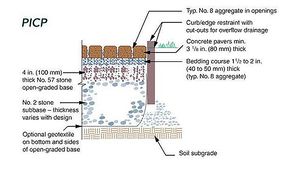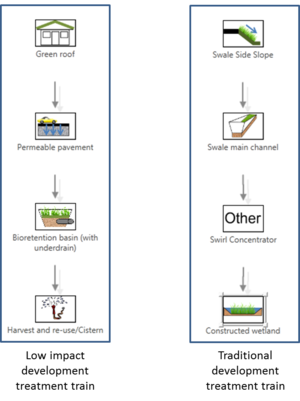
Difference between revisions of "Green Infrastructure benefits of permeable pavement"
| Line 76: | Line 76: | ||
Information regarding performance summaries of permeable pavement can be found here. | Information regarding performance summaries of permeable pavement can be found here. | ||
| − | Additional general information on permeable pavement can be found [[https://stormwater.pca.state.mn.us/index.php?title=Fact_sheets_for_permeable_pavement]]. | + | Additional general information on permeable pavement can be found [[https://stormwater.pca.state.mn.us/index.php?title=Fact_sheets_for_permeable_pavement Fact here]]. |
Additional considerations for permeable pavement can be found here. | Additional considerations for permeable pavement can be found here. | ||
NOTE: It is highly recommended that permeable pavement should NOT be used in areas of high traffic volume, with heavy equipment, or with frequent start and stopping. | NOTE: It is highly recommended that permeable pavement should NOT be used in areas of high traffic volume, with heavy equipment, or with frequent start and stopping. | ||
Revision as of 16:12, 30 August 2022
Contents
Green infrastructure and multiple benefits
Green infrastructure (GI) encompasses a wide array of practices, including stormwater management. Green stormwater infrastructure (GSI) encompasses a variety of practices primarily designed for managing stormwater runoff but that provide additional benefits such as habitat or aesthetic value. There is no universal definition of GI or GSI (link here for more information). Consequently, the terms are often interchanged, leading to confusion and misinterpretation. GSI practices are designed to function as stormwater practices first (e.g. flood control, treatment of runoff, volume control), but they can provide additional benefits. Though designed for stormwater function, GSI practices, where appropriate, should be designed to deliver multiple benefits (often termed "multiple stacked benefits". For more information on green infrastructure, ecosystem services, and sustainability, link to Multiple benefits of green infrastructure and role of green infrastructure in sustainability and ecosystem services.
Permeable pavement
Permeable pavement is a beneficial technology for stormwater management. This technology is highly beneficial for long term soil and water preservation of a site and has significant water quality impact for downstream systems such as lakes, rivers, and ponds. This technology operates by allowing water to flush quickly through pavement systems that would otherwise act as a conveyance system and remove water from a site. This water is instead drained directly downward through the pavement and into the ground underneath.
When designing a system, it is recommended to determine if permeable pavement would be feasible. Smaller sites may not see as much benefit due to lower runoff volumes but roadways, parking lots, and any other appropriate paved surface may benefit from this. Permeable pavement can be used in conjunction with other stormwater measures to ensure maximum benefit. Some key examples are:
- Permeable pavement built with underground cisterns, vaults, or other treatment devices
- Permeable pavement used with irrigation stormwater reuse
- Increased vegetation options at a site due to increased groundwater accessibility
- Systems in which other infiltration methods are difficult to achieve or may cause detrimental effects
Different types of permeable pavement include:
- Interlocking pavers
- Pervious concrete
- Porous asphalt
- Plastic grid pavers
With this in mind, permeable pavement can also be used to increase the safety of a site as it has been shown to increase traction for roadways during adverse weather and when used in outdoor sporting courts such as tennis and basketball, it can help prevent injuries by reducing the water that pools on the site.
For more information on how permeable pavements work please click here.
Green Infrastructure benefits of infiltration practices
Water quality: Pollutants are removed through stormwater runoff reduction when permeable pavement is used. This allows for vegetation and biota growth, vegetative filtering, and soil adsorption when rainfall events occur at the site.
Water quantity and hydrology: Reduction in total water volume movement and retardation of peak flow from rainfall events. Helps protect from downstream flooding and can be used in conjunction with reuse systems to reduce required water consumption for onsite irrigation. Infiltration also will recharge local groundwater.
Energy: Main energy savings comes from reduced energy requirements for wastewater treatment.
Air quality: Benefits are largely indirect, such as carbon sequestration.
Climate resiliency: Alleviates the impact on flooding, saves water through reuse systems, reduction of downstream pollutant loading
Habitat improvement: Reduction of soil erosion and increased soil stability promotes vegetation growth. Reduction in water temperature changes as a result of volume flow reduction. Retention of water on site helps ensure available water for vegetation and wildlife.
Community livability: Well designed permeable pavement practices helps to protect recreation sites for people by ensuring safe and healthy access to water sources. Water quality benefits from permeable pavement promote healthy water sources for diverse vegetation growth. This diversity allows for more heterogeneous plant growth and if the water quality is good enough, gardening practices of the local community may not be impacted. Reduction in water on surface ways helps improve safety for driving and human use.
Health benefits: Reduction of nutrients, pathogens, metals, TSS, and phosphorus among others. Increased longevity for fish and wildlife in the area through the reduction of compounds that would be washed into waterways as rain runoff.
Economic benefits and savings: In addition to water quality and flood control benefits, properly installed permeable pavers can prevent downstream cleanup needs. Permeable pavement that benefits vegetation can increase property aesthetics that increase property value.
Design considerations
Maximizing specific green infrastructure (GI) benefits of constructed areas requires design considerations prior to installation. While site limitations cannot always be overcome, the following recommendations are given to maximize the GI benefit.
Note: Permeable pavement SHOULD NOT be used in areas of high traffic volume, with heavy equipment, or with frequent start and stopping.
- Water quality
- Place the permeable pavement in a location where the majority of water flows through or to
- Design to maximize retention time and prevent short-circuiting
- Plan for the expected loading on the permeable pavement and ensure capabilities versus use line up
- Use in conjunction with other treatments to establish a treatment train or reuse water on site
- Water quantity and hydrology:
- Permeable pavement can significantly reduce the runoff and can be used to meet the water quality volume treatment requirement per the Construction Stormwater Permit
- Climate resiliency:
- Established systems using permeable pavement reduces the runoff impact on surrounding waterways through decreased pollutant loads and increased infiltration
- Permeable pavement systems can be established to support vegetation through water reuse systems, promoting further enhancement of water
- Habitat improvement:
- Reduction in chlorides needed as water infiltrates through relatively quickly when melted
- Community livability:
- Community members, depending on the system used, will likely not even realize the system is in place
- Development of permeable systems can promote mental health through better vegetation from the increased water storage and erosion reduction on site
- Develop conveyance systems in such a way to minimize changes in temperature that can be detrimental to wildlife populations
- Health benefits:
- Safety of community is improved by water infiltrating quickly through the pavement, less pooling of water and ice means less slipping hazards
- Minimizes mosquito by reducing standing water on site that impermeable pavement would otherwise offer
- Economic benefits and savings:
- Reduction in maintenance cost for vegetation if water reuse system is used in conjunction with permeable pavement
- Reduction in land space required as the pervious area can serve a dual purpose for cement and treatment that would otherwise be ineligible for water quality volume treatment
- Integrates infiltration into landscape design, including creating habitat, pathways, picnic areas, etc.
Information regarding performance summaries of permeable pavement can be found here.
Additional general information on permeable pavement can be found [Fact here].
Additional considerations for permeable pavement can be found here.
NOTE: It is highly recommended that permeable pavement should NOT be used in areas of high traffic volume, with heavy equipment, or with frequent start and stopping.

